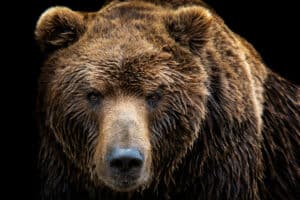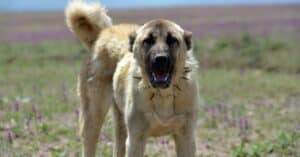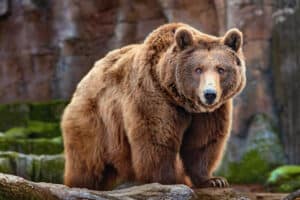Cave bears are so-named due to their tendency to hide and hibernate in caves. These ancient bears are actually two distinct species: Ursus spelaeus and Ursus deningeri. Both species are now extinct. But when they lived, these bears were quite large and imposing.
Just how big were these bears? And what did they eat to help them get to and maintain their size?
Description and Size
Cave bears grew to be between 880 and 2,200 pounds. This is roughly the size of today’s Kodiak or Polar bears, two of the largest species of modern bears. They looked similar to modern bears and are part of the same genus. The two main species of cave bears are Ursus spelaeus and Ursus deningeri. Some scientists believe that the U. deningeri were predecessors to the U. spelaeus, the true cave bear. Others maintain that they coexisted as two separate species.
Cave bears looked a lot like large modern bears. They had big heads with a steeply inclined forehead and a snout. They walked on four legs, with a strong muscular structure. Their shins were particularly large.
Male cave bears were quite a bit larger than females. Males typically weighed between 800 and 1,400 pounds, although some of the largest cave bears got up to over 2,000 pounds. Females were often closer to 500 pounds. Interestingly, during periods of more intense cold, cave bears evolved to become even larger. Scientists theorize that this helped them keep their body temperatures up. Cave bear skeletons from the warmer parts of the periods were on the smaller side. These changes did not occur within a single bear’s lifetime, however. They were evolutionary adjustments that impacted the species over many, many years.
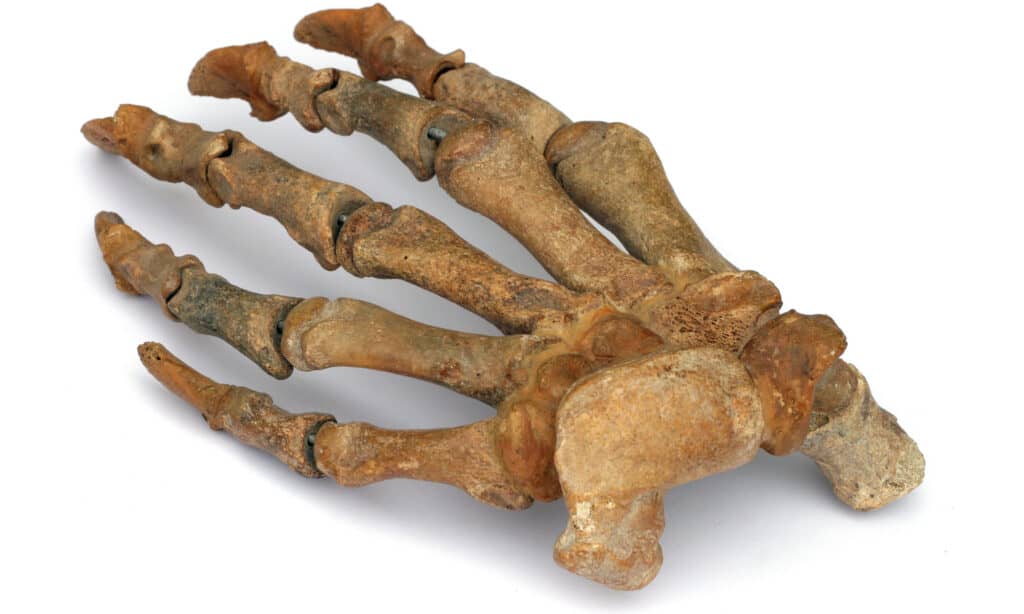
Cave bears looked much like modern bears and walked on all four paws.
©troy/Shutterstock.com
Cave Bear Scientific Classification
| Kingdom: Animalia | |
| Phylum: Chordata | |
| Class: Mammalia | |
| Order: Carnivora | |
| Family: Ursidae | |
| Genus: Ursus | |
| Species: Ursus spelaeus and Ursus deningeri |
What Did Cave Bears Eat?
Surprisingly, cave bears were actually herbivores who ate plants rather than animal protein. Modern bears like their share of plants, especially the Spectacled Bear. Cave bears favored areas with plenty of caves over plains or grasslands. They foraged on plants found in temperate forests and other similar locations.
The cave bear’s teeth tell researchers a lot about what they ate. Most were significantly worn from chewing fibrous materials like plants. Cave bears also evolved to have molars, making them even better suited to chew through tough plants.
As with most animals, access to food plays a big part in the cave bear’s diet. During months of hibernation, cave bears may have even resorted to cannibalism to stay alive. There is some evidence on cave bear bones that other animals may have chewed on them. These bones were found in a cave where the only other animals capable of this were other cave bears.
Habitat: When and Where It Lived
Cave bears lived during the Pleistocene epoch, between 2.6 million and 11,700 years ago. These ancient bears are similar to modern bears but the species of cave bears went extinct between 28,000 and 27,000 years ago.
Not surprisingly, cave bears tended to live in caves. These provided safety during the long months of hibernation. Their preference for these safe, enclosed spaces went beyond shelter during hibernation, however. Cave bears may have lived the majority of their lives in and around caves. They likely used them as shelter as well as to keep warm and protected.
Many bears, including modern bears, hibernate in caves. They are protected from the elements and predators. Caves can also keep heat inside, a significant impact on the bear’s survival during long periods without food.
Cave bears predominantly lived in forested and mountainous areas where caves were plentiful. Their skeletons have been discovered throughout Europe, including Great Britain, Spain, France, Italy, Germany, Switzerland, Austria, Poland, the Balkans, Romania, Georgia, and Russia. The northern parts of Europe, including Scotland, Scandinavia, and other Baltic countries were too cold and glacial during this time for cave bears to live.
Threats and Predators
Just like modern-day bears, cave bears hibernated. This period without food and water during intensely cold weather resulted in high mortality rates for cave bears. Bears that did not eat enough to prepare for this time did not survive. Bears that did not find suitable shelter also did not survive. Cave bears spent a large portion of their lives preparing for hibernation to ensure that they made it through the winter. Young cave bear cubs and older cave bears were especially vulnerable to the elements.
Other cave-dwelling animals, such as cave lions, probably competed with cave bears for shelter and resources. Because of their large size, it is unlikely that cave lions took on an adult cave bear on their own. Instead, they would probably target young or old cave bears that were weaker.
Prehistoric humans did have some interaction with cave bears and probably hunted them. Due to their large size, a single cave bear kill would feed people for many meals. While there is evidence that humans hunted and ate cave bears during this period, they were not a significant threat to the species’ survival.
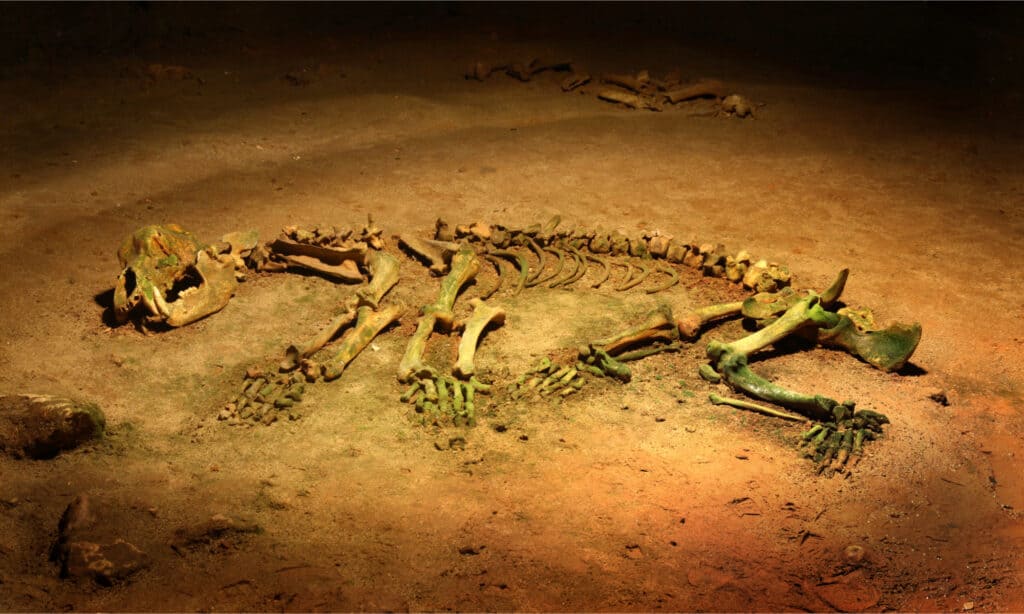
Cave bears were primarily vegetarian, though there is fossil evidence that they resorted to resorted to cannibalism to stay alive when food was scarce.
©Horia Bogdan/Shutterstock.com
Discoveries and Fossils: Where It Was Found
Cave bear remains are often found in caves. Even for prehistoric humans, the sight of cave bear bones was likely not an unusual one. Modern scientists can use carbon dating to learn more about how long the bones have been in the cave as well as the genetics of cave bears.
Scientists discovered cave bear bones in Spain in 2013. Following this discovery, the team of researchers reconstructed the mitochondrial DNA sequence of the cave bear. They found that this specimen lived more than 300,000 years ago! This was one of the oldest reconstructions of a specimen other than those discovered in the earth’s permafrost.
In the early 1900s, scientist Dr. Emil Bächler discovered cave bear remains alongside human artifacts in a cave in Switzerland. At the time, scientists theorized that the early humans had used the cave bear bones in religious rituals. Some even believed that the cave bears were worshipped. Modern scientists no longer support this theory. It is more likely the early humans used cave bear bones to survive, similar to the way they used other animal parts for shelter, food, or tools.
Extinction: When Did It Die Out?
Cave bears probably went extinct over a period of 1,000 years or more. Rather than one catastrophic event, cave bear numbers dwindled as the elements and lack of food and shelter impacted their survival rates. These animals were large and subsisted almost exclusively on plants and vegetation. Even a small change in the available food may have been enough to make it hard for them to eat enough to sustain themselves during hibernation.
Animals, including cave bears, are more susceptible to disease and illness when they are undernourished. When you add in the extreme conditions of glacial winters, being a cave bear was a tough life indeed!
Similar Animals to the Cave Bear
Cave bears are similar in size and structure to modern Kodiak bears and other Brown Bears. Other bears living at the time included:
- Kodiak bear: The largest of the modern bears, Kodiak bears can rival some cave bears in size. They are omnivores and eat both plants and animals. Kodiak bears live in the Kodiak Archipelago in Alaska. They are a species of Brown Bear and sometimes called the Alaskan Brown Bear.
- Spectacled bear: These South American bears may not be as big as cave bears but they are lovers of berries, just like their ancient buddies. They don’t hibernate. Instead, they eat all year long and can subsist on plants and vegetation. They are omnivores, however, and will eat animal protein sometimes.
- Arctotherium angustidens: This ancient bear is even larger than cave bears! They lived in South America during the same time frame, roughly 2.5 million to 11,700 years ago. They could get up to 4,000 pounds and are believed to be the largest carnivorous land mammal on record.
The photo featured at the top of this post is © Liliya Butenko/Shutterstock.com
FAQs (Frequently Asked Questions)
When did the cave bear live?
Cave bears lived between 2.6 million and 28,000 years ago. They roamed through most of Europe, favoring the mountains where caves and food were plentiful. Researchers believe that cave bears went extinct between 28,000 and 27,000 years ago.
How big was a cave bear?
Cave bears were comparable in size to today’s largest bears, the Kodiak Brown Bears. Male cave bears grew larger than females. Male cave bears could get up to more than 2,000 pounds, although most ranged between 800 and 1,400 pounds. Females grew to be around 500 pounds, sometimes more.
What did cave bears eat?
Cave bears ate plants and other vegetation. Remains of cave bear skulls and teeth show that they ground tough, fibrous foods like plants.
Did cave bears really live only in caves?
While they preferred caves much more than any other species of bear, cave bears still ventured out to find food and other bears. They probably left their caves during the day or night, returning when they needed shelter. Unlike other bears who only use caves during hibernation, cave bears lived in them year-round. This behavior led to their naming.
Were cave bears worshipped by prehistoric people?
When scientists discovered cave bear bones alongside prehistoric human remains and ritual sites, they believed that prehistoric people may have worshiped cave bears. While they likely respected the giant animals, it is not likely that they viewed them as deities or used them in any sort of religious rituals. Prehistoric people probably did use cave bear bones as tools, making use of all parts of the animals to help their own survival. Because of the highly romanticized idea, many people’s imaginations still run wild with stories of ancient cave bear worship.
Thank you for reading! Have some feedback for us? Contact the AZ Animals editorial team.



